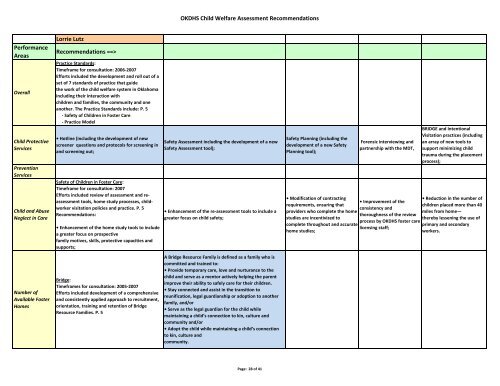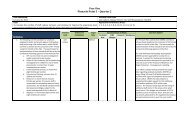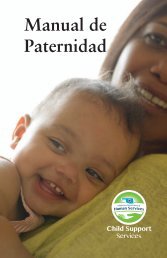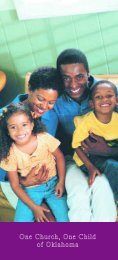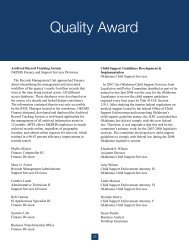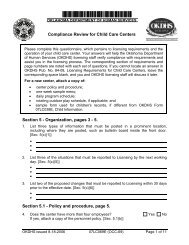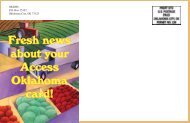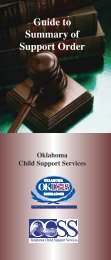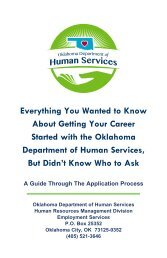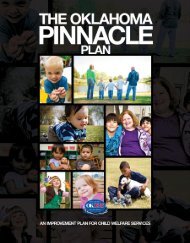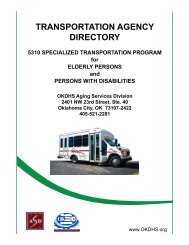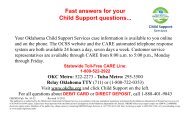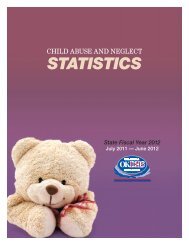Okdhs Child Welfare Assessment Recommendations - Oklahoma ...
Okdhs Child Welfare Assessment Recommendations - Oklahoma ...
Okdhs Child Welfare Assessment Recommendations - Oklahoma ...
You also want an ePaper? Increase the reach of your titles
YUMPU automatically turns print PDFs into web optimized ePapers that Google loves.
OKDHS <strong>Child</strong> <strong>Welfare</strong> <strong>Assessment</strong> <strong>Recommendations</strong><br />
Performance<br />
Areas<br />
Overall<br />
<strong>Child</strong> Protective<br />
Services<br />
Prevention<br />
Services<br />
<strong>Child</strong> and Abuse<br />
Neglect in Care<br />
Lorrie Lutz<br />
<strong>Recommendations</strong> ==><br />
Practice Standards:<br />
Timeframe for consultation: 2006-2007<br />
Efforts included the development and roll out of a<br />
set of 7 standards of practice that guide<br />
the work of the child welfare system in <strong>Oklahoma</strong><br />
including their interaction with<br />
children and families, the community and one<br />
another. The Practice Standards include: P. 5<br />
- Safety of <strong>Child</strong>ren in Foster Care<br />
- Practice Model<br />
• Hotline (including the development of new<br />
screener questions and protocols for screening in<br />
and screening out;<br />
Safety of <strong>Child</strong>ren in Foster Care:<br />
Timeframe for consultation: 2007<br />
Efforts included review of assessment and reassessment<br />
tools, home study processes, childworker<br />
visitation policies and practice. P. 5<br />
<strong>Recommendations</strong>:<br />
• Enhancement of the home study tools to include<br />
a greater focus on prospective<br />
family motives, skills, protective capacities and<br />
supports;<br />
Safety <strong>Assessment</strong> including the development of a new<br />
Safety <strong>Assessment</strong> tool);<br />
• Enhancement of the re‐assessment tools to include a<br />
greater focus on child safety;<br />
Safety Planning (including the<br />
development of a new Safety<br />
Planning tool);<br />
• Modification of contracting<br />
requirements, ensuring that<br />
providers who complete the home<br />
studies are incentivized to<br />
complete throughout and accurate<br />
home studies;<br />
Forensic interviewing and<br />
partnership with the MDT,<br />
• Improvement of the<br />
consistency and<br />
thoroughness of the review<br />
process by OKDHS foster care<br />
licensing staff;<br />
BRIDGE and Intentional<br />
Visitation practices (including<br />
an array of new tools to<br />
support minimizing child<br />
trauma during the placement<br />
process);<br />
• Reduction in the number of<br />
children placed more than 40<br />
miles from home—<br />
thereby lessening the use of<br />
primary and secondary<br />
workers.<br />
Number of<br />
Available Foster<br />
Homes<br />
Bridge:<br />
Timeframes for consultation: 2005-2007<br />
Efforts included development of a comprehensive<br />
and consistently applied approach to recruitment,<br />
orientation, training and retention of Bridge<br />
Resource Families. P. 5<br />
A Bridge Resource Family is defined as a family who is<br />
committed and trained to:<br />
• Provide temporary care, love and nurturance to the<br />
child and serve as a mentor actively helping the parent<br />
improve their ability to safely care for their children.<br />
• Stay connected and assist in the transition to<br />
reunification, legal guardianship or adoption to another<br />
family, and/or<br />
• Serve as the legal guardian for the child while<br />
maintaining a child’s connection to kin, culture and<br />
community and/or<br />
• Adopt the child while maintaining a child’s connection<br />
to kin, culture and<br />
community.<br />
Page: 28 of 41


